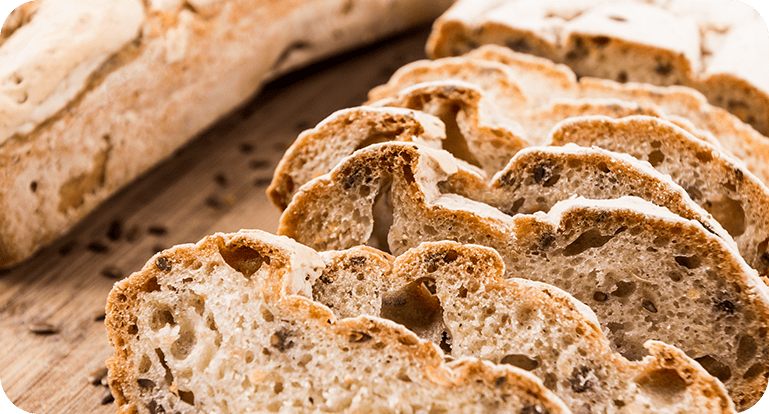THE GLUTEN-FREE DIET

A Beginner’s Guide
A gluten-free diet involves excluding foods that contain the protein gluten, including wheat, rye and barley and is typically followed by people with gluten sensitivity who will experience discomfort and some adverse health effects.
WHAT IS GLUTEN?
Gluten is a family of proteins found in wheat, barley, rye and spelt and gives flour a sticky consistency when mixed with water and gives bread the ability to rise when baked as well as its chewy and satisfying texture.
However, some people are sensitive to gluten and feel uncomfortable after eating foods that contain gluten. The most severe reaction is called the Celiac disease, an autoimmune disorder and affects up to 1% of the population and causes damage to the intestines.
GLUTEN NOT FOR EVERYONE
People with gluten intolerance or celiac disease and other disorders like wheat allergy and non-celiac gluten sensitivity frequently avoid it.
People who are non-celiac gluten sensitive will feel uncomfortable after eating gluten and the usual symptoms may include stomach pain, bloating, changes in bowel motions, tiredness and eczema or a rash.

MORE ABOUT GLUTEN-FREE DIETS
- HEALTH BENEFITS OF A GLUTEN-FREE DIET
- POSSIBLE SIDE EFFECTS AND HOW TO MINIMIZE THEM
- TYPICAL FOOD TO AVOID
- AN IDEAL DIET
Most people try a gluten-free diet to treat digestive problems which includes bloating, diarrhea or constipation, gas, fatigue and many other symptoms.
Switching to a gluten-free diet may also help boost your energy levels and stop you from feeling tired and sluggish
And last but not least, It is not unusual to lose weight when you start following a gluten-free diet and this is because it eliminates many junk foods that add unwanted calories to the diet. These foods are often replaced by fruit, veggies and lean proteins.
Focus on eating plenty of whole, unprocessed foods like fruits, veggies and lean proteins.
Source: https://www.healthline.com/nutrition/gluten-free-diet#health-benefits
Studies have found that following a gluten-free diet may not help treat nutritional deficiencies because people tend to choose more processed foods labeled as “gluten-free” over nutritious foods like fruits and vegetables.
Constipation is also a common side-effect because gluten-free diets eliminate many popular sources of fiber like bread, bran and other wheat-based products. In addition, many gluten-free substitutes for wheat-based products are low in fiber and would be another reason why constipation is common.
Eating a fiber-rich diet may help promote healthy bowel movements and if you experience constipation on a gluten-free diet, aim to eat more fiber-rich fruits and vegetables, such as broccoli, beans, lentils, brussels sprouts and berries.
Following a gluten-free diet can be difficult on a tight budget as gluten-free foods are more expensive to make as such food must pass stricter testing and avoid becoming contaminated. Therefore, try to eat more whole, single-ingredient foods, as they cost less.
Many social situations revolve around food and can make it difficult for you to socialize if you are following a gluten-free diet. If you are eating out, you may need to bring your own food.
Source: https://www.healthline.com/nutrition/gluten-free-diet#health-benefits
Completely avoiding gluten can be challenging because it is found in many common ingredients that are added to foods.
The following are the usual sources of gluten in a typical diet:
- Wheat-based foods like wheat bran, wheat flour, spelt, durum, kamut and semolina
- Barley
- Rye
- Triticale
- Malt
- Brewer’s yeast
Gluten can also be found within foods like:
- Bread: All wheat-based bread.
- Pasta: All wheat-based pasta.
- Cereals: Unless labeled gluten-free.
- Baked goods: Cakes, cookies, muffins, pizza, bread crumbs and pastries.
- Snack foods: Candy, muesli bars, crackers, pre-packaged convenience foods, roasted nuts, flavored chips and popcorn, pretzels.
- Sauces: Soy sauce, teriyaki sauce, hoisin sauce, marinades, salad dressings.
- Beverages: Beer, flavored alcoholic beverages.
- Other foods: Couscous, broth (unless labeled gluten-free).
The easiest way to avoid gluten is to eat unprocessed, single-ingredient foods and to read the food labels of most foods you buy.
Source: https://www.healthline.com/nutrition/gluten-free-diet#health-benefits
The following foods are naturally gluten-free:
- Meats and Fish: All meats and fish, except battered or coated meats.
- Eggs: All types of eggs are naturally gluten-free.
- Dairy: Plain dairy products, such as plain milk, plain yogurt and cheeses. However, flavored dairy products may have added ingredients that contain gluten, so you will need to read the food labels.
- Fruits and Vegetables: All fruits and vegetables are naturally free of gluten.
- Grains: Quinoa, rice, buckwheat, tapioca, sorghum, corn, millet, amaranth, arrowroot, teff and oats (if labeled gluten-free).
- Starches and Flours: Potatoes, potato flour, corn, corn flour, chickpea flour, soy flour, almond meal/flour, coconut flour and tapioca flour.
- Nuts and Seeds: All nuts and seeds.
- Spreads and Oils: All vegetable oils and butter.
- Herbs and Spices: All herbs and spices.
- Beverages: Most beverages, except for beer (unless labeled as gluten-free).
Source: https://www.healthline.com/nutrition/gluten-free-diet#health-benefits
